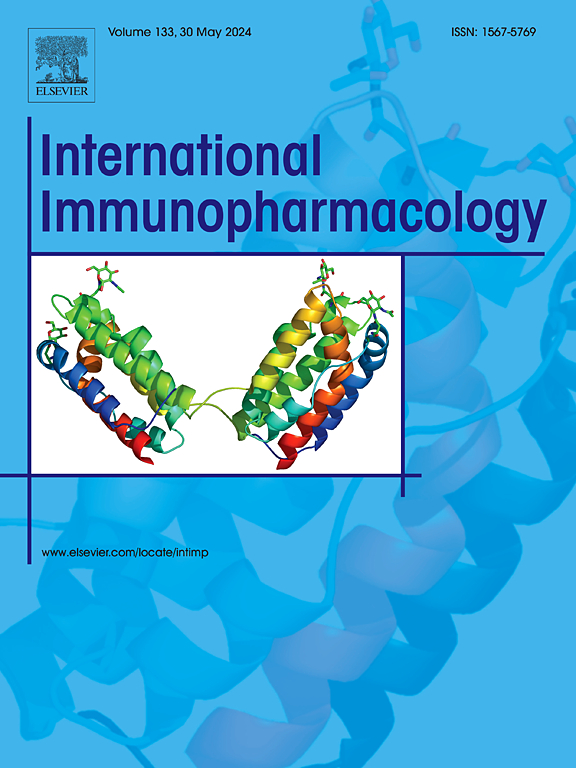NSMCE2通过调控PPARα的SUMOylation促进HCC的发生和发展
IF 4.8
2区 医学
Q2 IMMUNOLOGY
引用次数: 0
摘要
原发性肝癌是一种发生在消化系统的恶性肿瘤,是全球第六大最常诊断的癌症。它还上升为全球癌症相关死亡的第三大原因,仅次于肺癌和结直肠癌。肝细胞癌(HCC)占原发性肝癌的大多数,约占75%至85%。几项研究表明,NSMCE2通过其SUMO E3连接酶活性促进癌症,但其在HCC中的具体作用仍知之甚少。方法收集各种数据库数据,获得10对HCC患者组织样本,检测NSMCE2表达水平。此外,我们还进行了体内和体外实验,以证实NSMCE2对HCC发生和进展的影响。我们进一步通过生物信息学分析了NSMCE2调控HCC的潜在机制,并通过共免疫沉淀检测了NSMCE2调控PPARα的特异性机制。结果我们的研究表明NSMCE2在HCC中是一个重要的肿瘤启动子,并通过PPARα-CYP7A1轴起作用。具体来说,NSMCE2通过sumyylation PPARα,减少其泛素化降解,激活PPARα- cyp7a1轴,影响HCC的发生和进展。结论我们的研究揭示了NSMCE2在HCC发生发展中的作用,为HCC的发病机制和潜在的治疗策略提供了新的见解。本文章由计算机程序翻译,如有差异,请以英文原文为准。

NSMCE2 promotes the occurrence and development of HCC by regulating the SUMOylation of PPARα
Background
Primary liver cancer is a malignant tumor of the digestive system and ranks as the sixth most commonly diagnosed cancer globally. It has also risen to become the third leading cause of cancer-related deaths globally, following lung and colorectal cancers. Hepatocellular carcinoma (HCC) accounts for the majority of primary liver cancer, approximately 75 to 85 %. Several studies suggest that NSMCE2 contributes to cancer through its SUMO E3 ligase activity, yet its specific role in HCC remains poorly understood.
Methods
We gathered data from various databases and obtained 10 pairs of tissue samples from HCC patients to detect the NSMCE2 expression levels. Additionally, we conducted both in vivo and in vitro experiments to confirm the impact of NSMCE2 on the development and progression of HCC. We further analyzed the potential mechanism of NSMCE2 regulation on HCC by bioinformatics, and detected the specific mechanism of NSMCE2 regulating PPARα by co-immunoprecipitation.
Results
Our study shows that NSMCE2 is an important tumor promoter in HCC and acts through the PPARα-CYP7A1 axis. Specifically, NSMCE2 affects the occurrence and progression of HCC by SUMOylating PPARα, reducing its ubiquitination degradation, and activating the PPARα-CYP7A1 axis.
Conclusions
Our study uncovered the role of NSMCE2 in the development and progression of HCC, providing new insights into the pathogenesis and potential therapeutic strategies of HCC.
求助全文
通过发布文献求助,成功后即可免费获取论文全文。
去求助
来源期刊
CiteScore
8.40
自引率
3.60%
发文量
935
审稿时长
53 days
期刊介绍:
International Immunopharmacology is the primary vehicle for the publication of original research papers pertinent to the overlapping areas of immunology, pharmacology, cytokine biology, immunotherapy, immunopathology and immunotoxicology. Review articles that encompass these subjects are also welcome.
The subject material appropriate for submission includes:
• Clinical studies employing immunotherapy of any type including the use of: bacterial and chemical agents; thymic hormones, interferon, lymphokines, etc., in transplantation and diseases such as cancer, immunodeficiency, chronic infection and allergic, inflammatory or autoimmune disorders.
• Studies on the mechanisms of action of these agents for specific parameters of immune competence as well as the overall clinical state.
• Pre-clinical animal studies and in vitro studies on mechanisms of action with immunopotentiators, immunomodulators, immunoadjuvants and other pharmacological agents active on cells participating in immune or allergic responses.
• Pharmacological compounds, microbial products and toxicological agents that affect the lymphoid system, and their mechanisms of action.
• Agents that activate genes or modify transcription and translation within the immune response.
• Substances activated, generated, or released through immunologic or related pathways that are pharmacologically active.
• Production, function and regulation of cytokines and their receptors.
• Classical pharmacological studies on the effects of chemokines and bioactive factors released during immunological reactions.

 求助内容:
求助内容: 应助结果提醒方式:
应助结果提醒方式:


